http://books.google.com/books?id=OUzzzn ... tz&f=false
This short article ("Anhang") calls a few names of early German alchemists, which might be of interest to follow. If you take the German search engine, and the translation tool, perhaps you get something of it.
Personally I would say, that some of the pictures, that you present, are perhaps simply "normal". An ionography of the gods wasn't developed, so in "free style" they developed their view of it.
Perhaps it helps, if you take a look at at the "echecs amoureux" pictures, which also present gods and are not alchemical inspired.
http://classes.bnf.fr/echecs/feuille/amour/index.htm ... around 1467, the text from 1398
Re: Tarot-like images in a c.1420 manuscript
3Thanks, Huck. I can't seem to get the Google translation tool to produce a translation of the pages in German you referred me to. My impression, although I don't know for sure, is that Google doesn't digitalize whole pages in Google Books, just certain words, like in an index, linked to particular pages. If you do a Google-search of a specific sentence, put in quotes, that you know is on a particular page in Google Books, that page won't come up. Only certain combinations of words come up--key words, like proper names and subjects. At least that's been my experience. If sentences aren't digitalized, of course, the translation tool can't work on them.
I will study the images from "echecs amoureux," compare them to the ones in the c. 1420 manuscript, put my thoughts in order, and post a report. That may take a few days. They look like helpful, one way or another.
I will study the images from "echecs amoureux," compare them to the ones in the c. 1420 manuscript, put my thoughts in order, and post a report. That may take a few days. They look like helpful, one way or another.
Re: Tarot-like images in a c.1420 manuscript
4Hm, I'd the idea, that you just had to copy the names and attempt a general research on the connected names. This seems to be the more important persons in early alchemy. Generally I would imagine, that you get the better results at German pages.
Huck
http://trionfi.com
http://trionfi.com
Re: Tarot-like images in a c.1420 manuscript
5I see what you mean about "copying the names." But in the article you linked to, I cannot tell who the alchemists are, as opposed to other persons, without doing a lot of translation work first. And there are many, many alchemists. For the moment, I will stick with English-language sources for the names and use sources in other languages for details on the ones that look promising. Thanks for the suggestion of making names a focus.
In dealing with the "echecs amoureux," it would be helpful to know what the chess allegory is that is being illustrated. Hmm. I see you don't know, either. You write (viewtopic.php?f=11&t=365&p=4628&hilit=e ... ote]Evrart da Conty has a major part of the book dedicated to the description of 16 Greek/Roman gods - the passage, where he related the 16 gods to the 32 figures couldn't be found - although we had this text from the library in a modern edition. It's written in Old French, and as nobody was perfect in French this research was difficult and there is no guarantee, that this passage doesn't exist. And the book is a monster as it offers very much text ... ca. 1000 pages, written in small letters.[/quote]
I also don't know the poem that is attached to the illustrations. Well, you give me some help, in the same post.
One chess analogy I see is in the first illustration on your link, where Juno gets the attribute of a a key to the treasure: I would guess that as the most powerful piece on the board, she is the key to winning. Another might be Mars as a knight making a move. Then there is Jupiter as the King staying put--except that he also flies like an eagle, not typical of the King in chess. And perhaps when Mercury kills Argus, or Apollo vanquishing monsters, that is some piece capturing another. But I am just speculating.
In general, yes, the illustrations of the gods were bent to particular purposes, depending on the text and other considerations on the artist's or patron's agenda: chess in one case, Christian moralizing using pagan sources in the other. And perhaps other purposes, unstated, as de Rola proposes for the Fulgentius Metaphoralis.
Comparing the representations of the gods in the two texts, I see much less relation to alchemy and tarot, and far less explicitly, in the "echecs amoureux" as compared with the "Fulgentius." To justify this statement, let me go through the images one by one, omitting only the "echecs" images that don't pertain to the images I have from the "Fulgentius" (i.e. Nature and Diana).
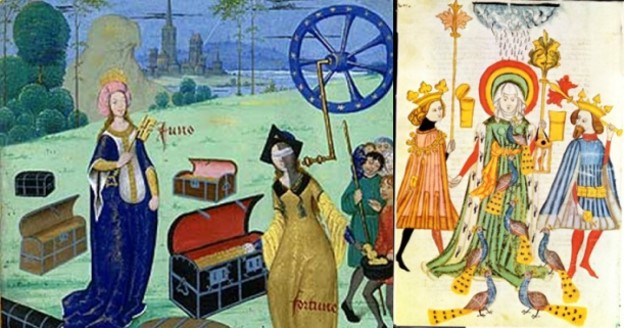
In the first illustration of Juno, the "echecs" has no rainbow, no married couple, no lantern--symbols that connect the "Fulgentius" to tarot and to alchemy. The key could possibly connect her to the tarot Popess (one of the Pope's keys).
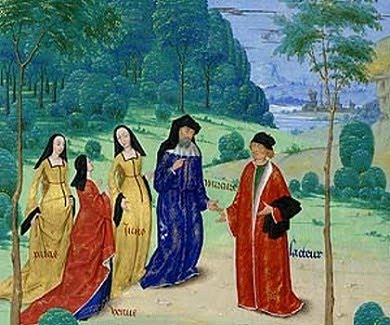
But I see that in a later image she might connect to marriage explicitly. Above, she might, as you suggest in your post on the other thread, be giving the Actor a choice between two ladies representing vice and virtue, as in the "Marseille" lover card. Perhaps the "Marseille" card borrowed from this image. But it is not the same as the alchemical scene, in which there is no choice between partners, just two partners already chosen, to be joined in wedlock. The "Fulgentius" gives us the alchemical version, the "echecs" a different one.
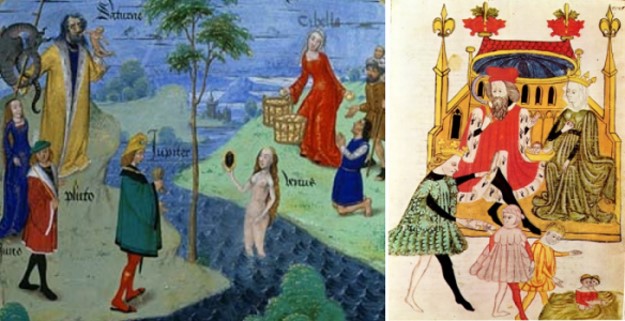
In the one of Saturn, the "echecs" omits the aspect of castration altogether, and his children are adults rather than children; thus it loses the connection both to alchemy and tarot. The uroboros dragon with Saturn, in the "echecs," is an alchemical symbol, but it was also common in non-alchemical texts. The portrayal of Cybele/Rhea here is interesting. I assume she is supposed to be a goddess of the harvest. Her fruits are vaguely like the coins that "Juno" is making in the "Fulgentius." To that degree there might be a reference to alchemy, but I doubt it. I see nothing in the "echecs" portrayal of her to suggest tarot.

In the one about Mercury, the "echecs" omits both the sword, an alchemical symbol for fire, and the various cooking pots, another alchemical symbol, often represented by scales. Hence it misses the connection to the tarot Justice card as well. So no reference here to either alchemy or tarot. With no table, it also loses the connection to the Bagatto.
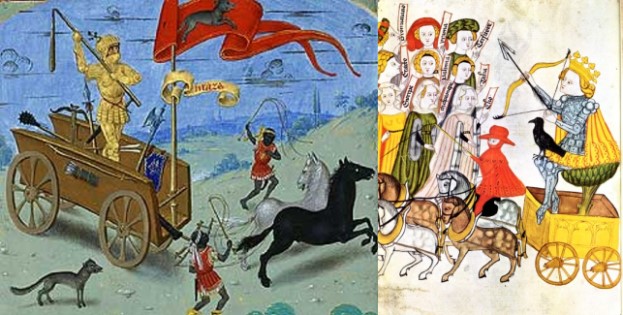
In the one about Mars, the chariot with the horses could be influenced by the tarot Chariot (not the other way around, as 1467 is too late). But gods on chariots, many different gods, were commonplace images. Surprisingly, I see possible alchemical references in both the "Echecs" Mars and the "Fulgentius" Apollo: red grooms, dark and white horses, yellow on the chariot. But the raven in the "Fulgentius" makes the relationship to alchemy more clear cut than on the "Echecs."
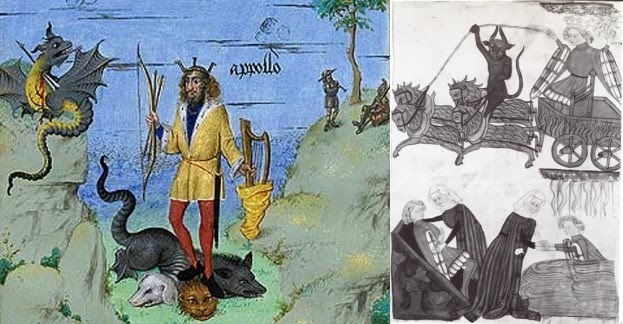
In the "Echecs" illustation about Apollo, the motif of the hero standing on the dragon (here, a webbed creature whose three heads represent past, present, and future) is a common one that was used in Christian art before it was adopted by alchemy. Apollo has his bow by his side, whereas the drawn bow is more common in alchemy. I see no relationship between this "Echecs" image and tarot. The other "Fulgentius" Apollo relates both to the Devil and Judgment cards (as well as the Chariot).
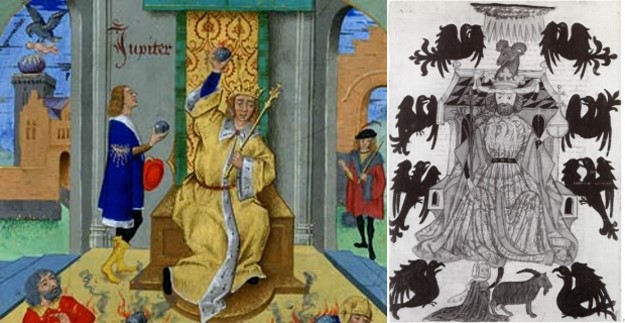
The two images featuring Jupiter are pretty comparable, although the orb in the "Fulgentius" clearly looks like a flask, unlike that of the "Echecs." As I have said, I don't see how the King as an eagle relates to chess. In relation to tarot: the Emperor is based in one place but can fly like an eagle when needed. In relation to alchemy: the prima materia is volatilized in the nigredo. The "Fulgentius" is similar to the "Echecs," but with the added suggestion of the nigredo, black death, which I don't see in the "echecs" image.
Then there is Venus of the "echecs" vs. that of the "Fulgentius":
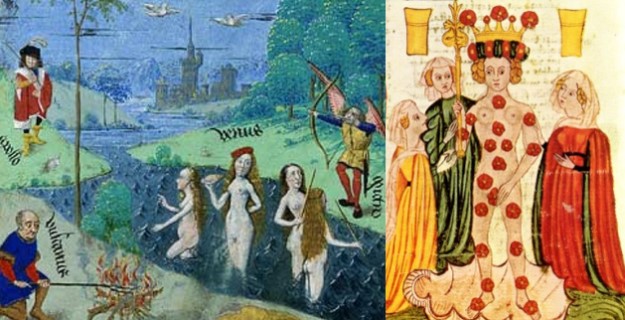
Even with the presence of Vulcan at his fire, I see no alchemical symbolism in the "echecs" image. But the "Fulgentius"' is a different story. Instead of one rose (her flower) demurely placed on her head like a cap, the "Fulgentius" has roses all over her body, like measles--or the change of color of the elixir with continued heat, from the white to the more potent red. In addition, putting her on the scallop shell suggests an alchemical interpretation, since what has occurred on the previous page (f. 226 before f. 227) is the castration of Saturn and the depositing of his genitalia in the soup (see Saturn, above), from which, transmuted, Venus arises.
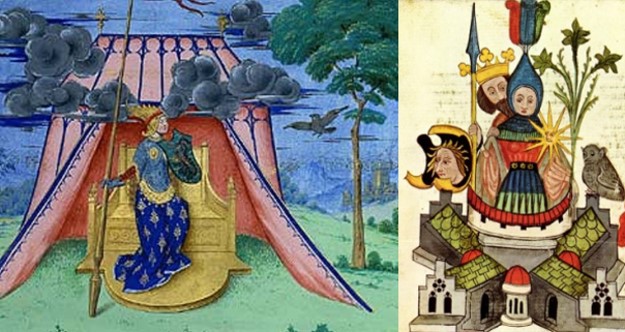
In the one about Athena, the owl and shield are attributes that I see also in the "Fulgentius" image, associating the woman there with Athena. So the "Fulgetius" image illustrates Athena,--among other things, perhaps. But there is less to suggest alchemy in the "echecs" one; in the "Fulgentius" there are the alchemical king and queen in the pot. The golden color of Athena in the "echecs" image, the last in this series, might be a reference to gold, the goal of alchemy, but more likely it was chosen to represent Wisdom. Conceivably it also refers to the Sun card, but without either a child or a pair of persons as well, the relationship to tarot is pretty speculative.
So in general, I would say that there is much less suggestion of either alchemy or tarot in the "echecs" than in the "Fulgentius." And of course the "echecs" is much later, so that if there was any relationship, we might expect more from the "echecs" than from the "Fulgentius."
While I am comparing images of the gods in 15th century manuscripts, consider the corresponding images from the Libellus, also around 1420 (per Seznec). (I get these from your post at viewtopic.php?f=12&t=463&start=50#p6315, where it is clear, from my quotes from Lazzarelli that you connected these pictures to, that Lazzarelli was basing his descriptions of the gods on these rather than on the "Mantegna" images. First, Saturn:
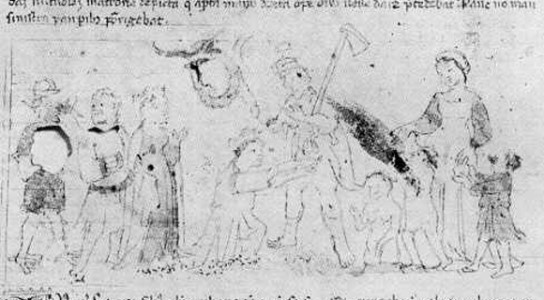
This reads like a combination of the "Fulgentius" and the "echecs" together in one scene. On the one hand, there is the all-important castration, which the "echecs" discreetly omitted. We also have believably childlike children. On the other hand, we have Saturn's uroboros dragon, Cybele passing out her fruit, and some adults standing around, too. I would say that the "Fulgentius" emphasized what was alchemically interesting from the Libellus, while the "Mantegna" took some of the rest.
Then here are the "Libellus's" Mars and Jupiter:
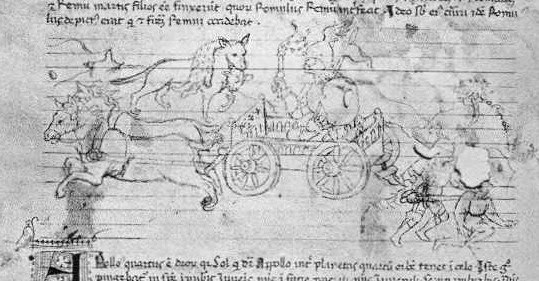
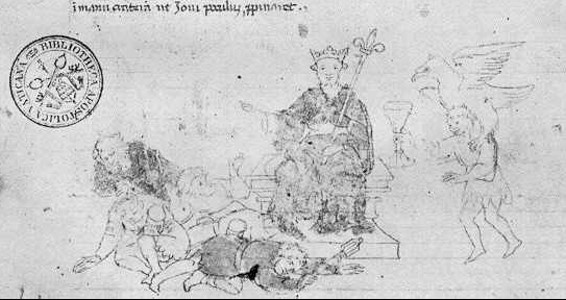
With Mars's flail and Jupiter's Ganymede, in content these are more like the "echecs" than the "Fulgentius," although the "echecs" has simplified the scenes somewhat (e.g. dropping Romulus and Remus, at the lower right of Mars). Again, the "Fulgentius" has taken the alchemically significant aspects of the Libellus and amplified them--turning Mars into the bow-readying Apollo with a raven and a red man, multiplying the eagles and dropping Ganymede (however it may be that the "Fulgentius" has a Mars of its own, which I haven't yet seen).
You also posted the "Libellus's" Mercury and a Venus (viewtopic.php?f=12&t=463&start=70#p6451), which are more of the same, again similar to the "Echecs" rather than to the "Fulgentius."
What is also striking is the similarity of many of these c. 1420 images --for both the "Fulgentius" and the "Libellus" (but not their Mercury or Venus)--to images that later appear in the tarot. Does the resemblance suggest that the tarot should be dated to that time, c. 1420, rather than 20 years later? I think more digging is in order.
In dealing with the "echecs amoureux," it would be helpful to know what the chess allegory is that is being illustrated. Hmm. I see you don't know, either. You write (viewtopic.php?f=11&t=365&p=4628&hilit=e ... ote]Evrart da Conty has a major part of the book dedicated to the description of 16 Greek/Roman gods - the passage, where he related the 16 gods to the 32 figures couldn't be found - although we had this text from the library in a modern edition. It's written in Old French, and as nobody was perfect in French this research was difficult and there is no guarantee, that this passage doesn't exist. And the book is a monster as it offers very much text ... ca. 1000 pages, written in small letters.[/quote]
I also don't know the poem that is attached to the illustrations. Well, you give me some help, in the same post.
I suspected as much, as "echecs amoureux" in French can mean either "chess lovers" or "failures in love." More fully, you wrote in another post (viewtopic.php?f=11&t=585&p=8719&hilit=e ... ):[quote]n the Echecs Amoureux of Evrart da Conty (ca. 1398) are used 16 gods and 32 "expanded elements" of the "Roman de la rose" to express the 32 Chess figures and Fortune is a figure in the opening, but not part of the game. "Nature" is another figure at this place, but also not part of the game. Juno appears (together with Fortune) and later Mercury together with Venus, Minerva and Juno (the Paris scene) and also present is the author. "Juno" stands likely for that, what the book is about, "wedding+marriage", Venus and Minerva are there as alternatives of the erotic life. Nature presents the force which drives the author to pair with the other gender. The author has the choice and strands in a chess game, which he loses .[/quote]This development was crowned by the "Echecs d'armour" of Evrart da Conty, in its length a monstrous work of encyclopedic dimensions, in which he organized as major plot a young man entering the garden of love and finding defeat in a chess game against a young girl.
One chess analogy I see is in the first illustration on your link, where Juno gets the attribute of a a key to the treasure: I would guess that as the most powerful piece on the board, she is the key to winning. Another might be Mars as a knight making a move. Then there is Jupiter as the King staying put--except that he also flies like an eagle, not typical of the King in chess. And perhaps when Mercury kills Argus, or Apollo vanquishing monsters, that is some piece capturing another. But I am just speculating.
In general, yes, the illustrations of the gods were bent to particular purposes, depending on the text and other considerations on the artist's or patron's agenda: chess in one case, Christian moralizing using pagan sources in the other. And perhaps other purposes, unstated, as de Rola proposes for the Fulgentius Metaphoralis.
Comparing the representations of the gods in the two texts, I see much less relation to alchemy and tarot, and far less explicitly, in the "echecs amoureux" as compared with the "Fulgentius." To justify this statement, let me go through the images one by one, omitting only the "echecs" images that don't pertain to the images I have from the "Fulgentius" (i.e. Nature and Diana).

In the first illustration of Juno, the "echecs" has no rainbow, no married couple, no lantern--symbols that connect the "Fulgentius" to tarot and to alchemy. The key could possibly connect her to the tarot Popess (one of the Pope's keys).

But I see that in a later image she might connect to marriage explicitly. Above, she might, as you suggest in your post on the other thread, be giving the Actor a choice between two ladies representing vice and virtue, as in the "Marseille" lover card. Perhaps the "Marseille" card borrowed from this image. But it is not the same as the alchemical scene, in which there is no choice between partners, just two partners already chosen, to be joined in wedlock. The "Fulgentius" gives us the alchemical version, the "echecs" a different one.

In the one of Saturn, the "echecs" omits the aspect of castration altogether, and his children are adults rather than children; thus it loses the connection both to alchemy and tarot. The uroboros dragon with Saturn, in the "echecs," is an alchemical symbol, but it was also common in non-alchemical texts. The portrayal of Cybele/Rhea here is interesting. I assume she is supposed to be a goddess of the harvest. Her fruits are vaguely like the coins that "Juno" is making in the "Fulgentius." To that degree there might be a reference to alchemy, but I doubt it. I see nothing in the "echecs" portrayal of her to suggest tarot.

In the one about Mercury, the "echecs" omits both the sword, an alchemical symbol for fire, and the various cooking pots, another alchemical symbol, often represented by scales. Hence it misses the connection to the tarot Justice card as well. So no reference here to either alchemy or tarot. With no table, it also loses the connection to the Bagatto.

In the one about Mars, the chariot with the horses could be influenced by the tarot Chariot (not the other way around, as 1467 is too late). But gods on chariots, many different gods, were commonplace images. Surprisingly, I see possible alchemical references in both the "Echecs" Mars and the "Fulgentius" Apollo: red grooms, dark and white horses, yellow on the chariot. But the raven in the "Fulgentius" makes the relationship to alchemy more clear cut than on the "Echecs."

In the "Echecs" illustation about Apollo, the motif of the hero standing on the dragon (here, a webbed creature whose three heads represent past, present, and future) is a common one that was used in Christian art before it was adopted by alchemy. Apollo has his bow by his side, whereas the drawn bow is more common in alchemy. I see no relationship between this "Echecs" image and tarot. The other "Fulgentius" Apollo relates both to the Devil and Judgment cards (as well as the Chariot).

The two images featuring Jupiter are pretty comparable, although the orb in the "Fulgentius" clearly looks like a flask, unlike that of the "Echecs." As I have said, I don't see how the King as an eagle relates to chess. In relation to tarot: the Emperor is based in one place but can fly like an eagle when needed. In relation to alchemy: the prima materia is volatilized in the nigredo. The "Fulgentius" is similar to the "Echecs," but with the added suggestion of the nigredo, black death, which I don't see in the "echecs" image.
Then there is Venus of the "echecs" vs. that of the "Fulgentius":

Even with the presence of Vulcan at his fire, I see no alchemical symbolism in the "echecs" image. But the "Fulgentius"' is a different story. Instead of one rose (her flower) demurely placed on her head like a cap, the "Fulgentius" has roses all over her body, like measles--or the change of color of the elixir with continued heat, from the white to the more potent red. In addition, putting her on the scallop shell suggests an alchemical interpretation, since what has occurred on the previous page (f. 226 before f. 227) is the castration of Saturn and the depositing of his genitalia in the soup (see Saturn, above), from which, transmuted, Venus arises.

In the one about Athena, the owl and shield are attributes that I see also in the "Fulgentius" image, associating the woman there with Athena. So the "Fulgetius" image illustrates Athena,--among other things, perhaps. But there is less to suggest alchemy in the "echecs" one; in the "Fulgentius" there are the alchemical king and queen in the pot. The golden color of Athena in the "echecs" image, the last in this series, might be a reference to gold, the goal of alchemy, but more likely it was chosen to represent Wisdom. Conceivably it also refers to the Sun card, but without either a child or a pair of persons as well, the relationship to tarot is pretty speculative.
So in general, I would say that there is much less suggestion of either alchemy or tarot in the "echecs" than in the "Fulgentius." And of course the "echecs" is much later, so that if there was any relationship, we might expect more from the "echecs" than from the "Fulgentius."
While I am comparing images of the gods in 15th century manuscripts, consider the corresponding images from the Libellus, also around 1420 (per Seznec). (I get these from your post at viewtopic.php?f=12&t=463&start=50#p6315, where it is clear, from my quotes from Lazzarelli that you connected these pictures to, that Lazzarelli was basing his descriptions of the gods on these rather than on the "Mantegna" images. First, Saturn:

This reads like a combination of the "Fulgentius" and the "echecs" together in one scene. On the one hand, there is the all-important castration, which the "echecs" discreetly omitted. We also have believably childlike children. On the other hand, we have Saturn's uroboros dragon, Cybele passing out her fruit, and some adults standing around, too. I would say that the "Fulgentius" emphasized what was alchemically interesting from the Libellus, while the "Mantegna" took some of the rest.
Then here are the "Libellus's" Mars and Jupiter:


With Mars's flail and Jupiter's Ganymede, in content these are more like the "echecs" than the "Fulgentius," although the "echecs" has simplified the scenes somewhat (e.g. dropping Romulus and Remus, at the lower right of Mars). Again, the "Fulgentius" has taken the alchemically significant aspects of the Libellus and amplified them--turning Mars into the bow-readying Apollo with a raven and a red man, multiplying the eagles and dropping Ganymede (however it may be that the "Fulgentius" has a Mars of its own, which I haven't yet seen).
You also posted the "Libellus's" Mercury and a Venus (viewtopic.php?f=12&t=463&start=70#p6451), which are more of the same, again similar to the "Echecs" rather than to the "Fulgentius."
What is also striking is the similarity of many of these c. 1420 images --for both the "Fulgentius" and the "Libellus" (but not their Mercury or Venus)--to images that later appear in the tarot. Does the resemblance suggest that the tarot should be dated to that time, c. 1420, rather than 20 years later? I think more digging is in order.
Re: Tarot-like images in a c.1420 manuscript
6Alright, I decided to help you a little bit ...mikeh wrote:I see what you mean about "copying the names." But in the article you linked to, I cannot tell who the alchemists are, as opposed to other persons, without doing a lot of translation work first. And there are many, many alchemists. For the moment, I will stick with English-language sources for the names and use sources in other languages for details on the ones that look promising. Thanks for the suggestion of making names a focus.
Albrecht III of Bavaria-Munich
http://de.wikipedia.org/wiki/Albrecht_III._%28Bayern%29
http://de.wikisource.org/wiki/ADB:Albre ... BCnchen%29
John the alchemist ... already told about
Kuno of Falkenstein, archbishop of Trier, two archbishop generations after Balduin
http://de.wikisource.org/wiki/ADB:Konra ... alkenstein
http://de.wikipedia.org/wiki/Kuno_II._von_Falkenstein
Werner of Falkenstein, his nephew
http://de.wikipedia.org/wiki/Werner_von_Falkenstein
Johann II of Baden
this was also a archbishop of Trier, likely he had heard from alchemical wonder stories
http://de.wikipedia.org/wiki/Jakob_II._von_Baden
was cheated by an "alchemist"
http://books.google.com/books?id=FtoAAA ... ie&f=false
The biographies don't speak of alchemy, but this occupation not naturally lies at the surface.
****************
Passau-or-Leuchtenberg-or- Grafschaft Hals circle (South-East Germany) "Alchymey teuczsch, codex. pal. Germ 597):
Niklas Jankowitch (had master function)
Michael Prapach
Michael Wülfling
a Friedrich (?)
That's just "Alchymey teuczsch" (means German Alchemy), there is a group of authors around the Leuchtenberg-family. This region is east of Ratisbon (Regensburg), not too far from Prague, not too far from Nurremberg.
Johannes von Leuchtenberg
Gerhard von Leuchtenberg
Graf "zu Hals"
Salman Teublein (a Jew)
see:
http://books.google.com/books?id=6_JS90 ... in&f=false
That's a story of two cousins, who hired a Jew, that was an alchemist.
Paulus Eck von Sulzbach
http://de.wikisource.org/wiki/ADB:Eck_v ... bach,_Paul
writer of alchemical works
Landgraf "Wilhem von Hessen" (c. 1500)
seems to have sponsored the above eck von Sulzbach)
Bärbel von Ottenheim
(this "Bärbel" ironical had to do with a "Lichtenberg"-family, which easily might be taken to have something to do with the Leuchtenbergs, but this seems not to have been so; this is an Alsace-story)
she got the accusation to have been a witch
Hinrich von Plauen
(had to do with the Schwarzenburg, wich earlier belonged to the Leuchtenbergs)
... Schwarzenburg ... here I started to think ...
The Leuchtenbergs had a great time in 14th century, when Charles IV. had been emperor. The "Schwarzenburg" they got in ...
... c. 1332. then the Leuchtenberger had them till ..Nach der Landesteilung von 1331 kam die Herrschaft zum Herzogtum Heinrichs XV. des Natternbergers, dieser verkaufte die Burg aber im folgenden Jahr für 3000 Pfund Regensburger Pfennige zusammen mit Rötz und Waldmünchen an den Landgrafen Ulrich von Leuchtenberg. Er musste sich dabei verpflichten, 400 Pfund Regensburger Pfennige in die Burg zu verbauen.
.. in 1404. Later in 1495 Heinrich Plauen had it till 1505 ... Heinrich von Plauen was also called an alchemist. What did he want with the Schwarzenburg, far away from his normal region Meissen? This puzzled me ... looking later for Heinrich von Plauen, I got that there were many Heinrichs von Plauens, that one, who was interested in alchemy, was the Deutschordenmeister, with strong involvement in the catastrophic battle of Tannenberg 1410, which prepared the downfall of the Deutscher Rittterorden. The Heinrich of Plauen, which, who bought the castle Schwarzenberg, was a later follower, who - curiously - got a rather successful son, who attacked the Plassenburg in Kulmbach in 1553 and died at that opportunity. Plassenburg was earlier the selected place for John the alchemist ... somehow strange.Die Leuchtenberger besaßen die Herrschaft Schwarzenburg-Rötz-Waldmünchen bis auf eine Verpfändung zwischen 1364 und 1367 an Georg Auer von Stockenfels bis etwa 1404, als sie die Herrschaft an Amalia Kagerin von Störnstein und ihre Söhne Hinczik und Hans die Pfluge zu Rabenstein verkauften. Unter den Pfluge, zuerst unter Hinczik, der nach 1460 verstarb, dann unter seinen Sohn Sebastian, er starb 1491/92, beide waren lange Zeit Pfleger zu Cham, und seinem Enkel Hinczik d.J., der 1495 gestorben ist, konnten sie die Rechte und Bedeutung der Herrschaft noch steigern. Zwischen 1439 und 1460 sind nicht näher bezeichnete Baumaßnahmen für 600 Gulden bekannt, sicher wurden zu dieser Zeit die drei noch erhaltenen Halbrundtürme, einer an dem turmförmigen Wohnbau der Hauptburg, einer innerhalb der Westbastion und einer neben dem erhaltenen inneren Tor der Vorburg, erbaut. Eventuell stand auch auf der gegenüberliegenden Seite des Tores noch ein zweiter Turm. Der Grund für die Verstärkung der Befestigungen dürfte wohl in der Bedrohung der Region durch die Hussitenkriege liegen. Die Schwarzenburg war 1433 Sammelplatz des unter Hinczik Pflug stehenden Heeres, das in der siegreichen Schlacht bei Hiltersried zu Bekanntheit gelangte.
1495 verkauften die Erben Hinczik d.J. für 36.000 Gulden die Herrschaft an Heinrich von Plauen, dem Burggrafen von Meißen. Heinrich war bis 1505 in Besitz von Burg und Herrschaft, er ließ umfangreiche Baumaßnahmen für 4.000 Gulden durchführen. Damals entstanden wohl die drei Bastionen, das Rondell, das Vortor der Vorburg und der ausgemauerte Halsgraben.
But the idea, which initiated my interest, was ... "Schwarzenburg? Alchemy? Gun Powder?" and so I started to look for Bertold Schwarz, a famous, but somehow very legendary inventor of the black powder, which changed the world. Very much contradicting stories about him. Many have searched for him, nobody really have found him. Well, indeed an invention, which could cause some interest in alchemic experiments ... his heirs would follow these paths. The Leuchtenbergs showed a clear bundled interest in such experiments ... John the Alchemist wasn't very far. The author's of the "German alchemy" were locally near. A lot of alchemy interests just in this region. And the region is very near to Prague, and Prague had been the empire center, so this region logical had an attraction for persons with somehow scientific interests. Nurremberg was near, a city with some proven genius for invention in this time.
One, a relative plausible, story tells of a ...
.. Berthold von Lützelstetten. who was between 1294-1310 as a Dominican in in Constance and taught in the years 1329 - 1336 in Paris. The bishop of Constance, Heinrich II (died 1306), is said to have made alchemical studies or "naturwissenschaftliche Studien". So the story looks plausible.Der Historiker H.J. Rieckenberg sieht in Berthold Schwarz den Konstanzer Domherrn Bertold von Lützelstetten (ein Ort bei Konstanz), der von 1294 bis 1310 Mitglied des dortigen Domkapitels war und als „magister artium Bertoldus“ in den Jahren 1329 bis 1336 vier Mal im Verzeichnis der Pariser Universität vorkommt.
1324 gunpowder was used in the battle of Metz, 1334 in Constance, 1337 against the Burg Eltz (near Trier) ... at least I found remarks, that this was so.
http://en.wikipedia.org/wiki/War_of_Metz
John the Blind and Baldwin of Luxembourg, his uncle belonged to the 4 attacker-groups. Baldwin was responsible for the siege of Burg Eltz 1337
*********************
... after a pause ...
Getting some rudimentary insight, what made this list of "early alchemists" is extremely difficult, as it demands a lot of building theoretical structures of early German history. Basic questions are:
1. Who are the Leuchtenbergs and what's there role in history?
2. How developed the Burggrafentum of Nurremberg?
3. How does this interact with the wealth and success of Nurremberg in the considered period?
4. What's the interaction between Leuchtenbergs and the Burggrafen of Nurremberg?
5. The Burggrafen of Nurremberg were the early Hohenzollern, who started a great line of success in 17th century, forming Brandenburg to Prussia and later dominating the Germany till the end of WWI. How does this later success interact with the earlier role as Burggraf of Nuremberg?
6. What role plays the 14th century Luxembourg dynasty in the early successes of the Leuchtenbergs and the city of Nurremberg and finally also the Burggrafen of Nurrember?
... and some more question, as for instance "what has this to do with gun-powder" and naturally this builds a sort of Tornado, in other words " not easy to understand and talk about".
Apparently the Leutenbergs play a dominant role in these German first atttempts of "alchemy in literature" as there are this book about the Heilige Dreifaltigkeit (1410 till the edition, which John the alchemist got) and the "German alchemy" of 1426. So the attempt is given to get to the base of it:
The "Heilige Dreifaltigkeit" was written first for Sigismund in 1410 by an otherwise unknown Franciscian Ulmannus and expanded later , and this was for John the alchemist. Just putting this into some "logic of the time"
Charles IV is a successful emperor from 1346-1378. He reigns from Prague (Bohemia), which logically helps regions at the border between the "usual empire" " and Bohemia a lot. So in this period the city Nurremberg (second capital), the Leuchtenberg region and the also the Burggraf of Nurremberg prosper from this development.
A big part of the success is, that the region of Bohemia wasn't hit very hard by the plague of 1348-50, naturally one may conclude, that also the region of the Leuchtenbergs and of Nurremberg didn't got the plague with full force.
In many parts of Europe Jews were killed and persecuted during the plague, but not in Prague. As for the theme "Alchemy" Jews seem to have some importance, that's a rather interesting aspects, which shouldn't be overlooked. And the role of Jews in the East-Western technology exchange should be clear, if not, start to think about it.
The influence of Jews in Prague was given for all the time till 20th century.
Charles married 4 times:
1. A French king's daughter (which says, he was interested in a good connection to France). She died 1348 and the relations cooled down.
2. A woman of Bavaria ... which says, he was interested in the relations to the regions at the border of the empire (Nurremberg, Leuchtenberg)
3. East-German woman
4. East German women ... the both latter indicate, that he was interested to get Brandenburg, which he got in 1373 - 1378
Alright, emperor Charles died and with him the lucky time of Bohemia. In 1381 there was a heavy Jews persecution even in Prague. For Tarot history relevant: The following weak king Wenzel sold the duke title to Giangaleazzo for a lot of money, but he got this way finally spo much opposition by German nobility, that he was abdicated in 1400. The new king Ruprecht (100 - 1410) was NOT of the Luxembourg dynasty, but he wasn't successful. Sigesmund (1410-37) replaced him (again Luxembourg).
In 1409 (important), at the university of Prague the German students left under protest and went to other universities.
In 1410 now we have the Heilige Dreifaltigkeit made for Sigismund.
One should see, that we have a lot of technological advance in the period of Charles IV (first university north of the Alps in Prague), then a slow down with Wenzel. Somehow in the downfall of Prague, it's logical, that the border regions jump into the new technological vacuum and attempt to fill the place (so Nurremberg advances, so the Leuchtenberg initiative, so Kulmbach advances) ... thanks to the earlier condition, that they prospered through the nearness to Prague.
So the text about the Heilige Dreifaltigkeit should be seen as a (somehow strange) side-path of a Science development. Similar the German alchemy of 1426. What happens next:
1415 council of Constance (Jan Hus of Bohemia killed), the Burggraf of Nurremberg gets Brandenburg.
Later The Hussites war, which attack German border regions.
1427 The Burggraf of Nurremberg sells regions around Nurremberg to the citizens. This had influence on two later movements
* 1449-50 : 1. Markgrafenkrieg ... smaller attempt to regain the earlier regions
* 1552-55 : 2. Markgrafenkrieg ... greater attempt and it ruined the financial stability of the city Nurremberg
Nürnbergs successful period is given as from 1470 - 1530. In this time "Nurremberg earned as much money as the whole kingdom of Bohemia" .. I don't know, if this is correct.
Then a little later this fine book for Johann the alchemist.
So let's go back to 14th century, with some realism: What's so interesting in Bohemia? Simple answer: there are mines in this period. Mining naturally develops special knowledge unknown to others and some natural interest to hide this technological knowledge.
Get here some shocking details:
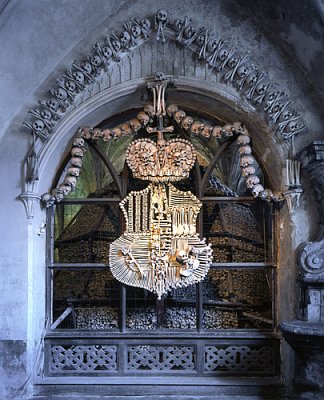
http://www.radio.cz/en/section/spotligh ... ng-history
http://en.wikipedia.org/wiki/Kutn%C3%A1_Hora
Later for 15th century we have: "Jakob [Fugger], called ‘the Wealthy’ (1459-1525) purchased copper and silver mines in Hungary, Karinthia, Spain and the Tyrol."
He became very rich, he financed, that Charles V. became emperor in 1519.
So Fugger got special knowledge about metallurgy ... in 1530 we see produced "Splendor Solis" (big alchemical work), made in Augsburg. So, what do you think, alchemy is about?
Naturally we have expect also other technological mysteries, anything, which had the potential to result in having "gold", which is just "having enough money". For instance also "gun-powder-knowledge". What's that the Hohenzollern became rich and mighty with? Wasn't that gun-powder knowledge finally? But not naturally this alone ...
Huck
http://trionfi.com
http://trionfi.com
Re: Tarot-like images in a c.1420 manuscript
7there is a further edition ...

Neptune, avec son trident, entouré des tritons .Évrard de Conty, Le Livre des échecs amoureux moralisés Enluminures de Robinet Testard, vers 1496-1498. Manuscrit sur parchemin (51 x34 cm) BNF, Manuscrits, français 143, f. 130 v°
... from which one finds occasionally pictures in the web, for instance this more concrete Saturn-Kronos, which you missed, here twice
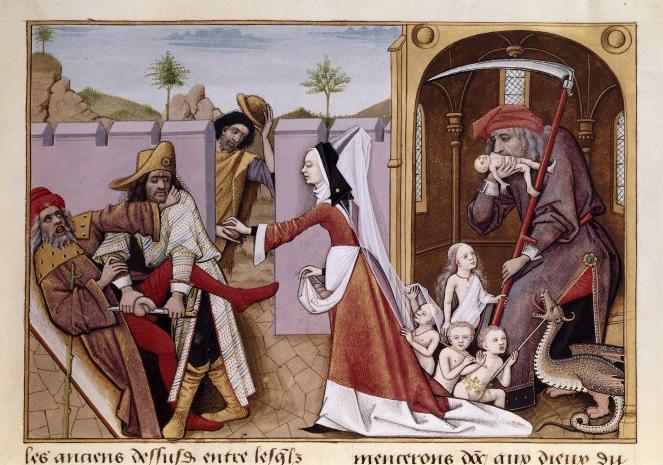
There is another version, from which I once had a few small pictures, but I lost them. They had stronger similarities to the older edition.

Neptune, avec son trident, entouré des tritons .Évrard de Conty, Le Livre des échecs amoureux moralisés Enluminures de Robinet Testard, vers 1496-1498. Manuscrit sur parchemin (51 x34 cm) BNF, Manuscrits, français 143, f. 130 v°
... from which one finds occasionally pictures in the web, for instance this more concrete Saturn-Kronos, which you missed, here twice

There is another version, from which I once had a few small pictures, but I lost them. They had stronger similarities to the older edition.
Huck
http://trionfi.com
http://trionfi.com
Re: Tarot-like images in a c.1420 manuscript
8Alchemy in England, April 1446 (already in 1402)
http://books.google.com/books?id=lnsPAA ... VI&f=false
Fauceby, Kirkebez and Raguy (for English king Henry VI; Sir Edmond de Trafford and Sir Thomas Ashton)
already in 1402
http://syNA&hl=en&ei=YlRLTeuKF8jqOaaZ8PsP&sa=X&oi=book_result&ct=result&resnum=6&sqi=2&ved=0CD4Q6AEwBQ#v=onepage&q=sir edmund trafford alchemist&f=false
and earlier: Chaucer at page 81, the Canon's Yeoman Tale
http://books.google.com/books?id=r8sUAA ... &q&f=false
http://books.google.com/books?id=lnsPAA ... VI&f=false
Fauceby, Kirkebez and Raguy (for English king Henry VI; Sir Edmond de Trafford and Sir Thomas Ashton)
already in 1402
http://syNA&hl=en&ei=YlRLTeuKF8jqOaaZ8PsP&sa=X&oi=book_result&ct=result&resnum=6&sqi=2&ved=0CD4Q6AEwBQ#v=onepage&q=sir edmund trafford alchemist&f=false
and earlier: Chaucer at page 81, the Canon's Yeoman Tale
http://books.google.com/books?id=r8sUAA ... &q&f=false
Last edited by Huck on 25 Mar 2020, 18:17, edited 2 times in total.
Huck
http://trionfi.com
http://trionfi.com
Re: Tarot-like images in a c.1420 manuscript
9Thanks for the research, Huck. I was looking for connections to Italy. There was of course Wenceslaus. And the "Italian court" at Kutna Hora looked intriguing. I've actually been to Kutna Hora and visited the alchemy museum there, a fairly good one. There are articles about that museum at various sites on the Web, one by JMD in fact. Kutna Hora naturally was a big center of alchemy.
Gunpowder of course is Chinese, invented by Chinese alchemists. There is an interesting book about the history of gunpowder, which talks about the role of alchemists in the West in adapting the invention to particular applications such as guns and mining, http://books.google.com/books?id=8o8EIs ... &f=false.I don't recall the author mentioning Jews in particular as conveying the invention westward, but my memory is fuzzy. The Chinese used gunpowder in warfare a lot early on. But they apparently became so horrified by its destructiveness that by consent on all sides they banned it--as a weapon of mass destruction, I presume. Not a bad idea.
In Italy I think the use of gunpowder, which didn't dominate warfare there until after the invention of the tarot, changed the way in which the tarot court cards were drawn, especially Batons and Swords, so that instead of optimistic court figures, we have ones who look upset. A similar change in attitude toward warfare was reflected in literature, from Ariosto to Shakespeare. Pictorial art besides the tarot also picked up on the change, for example Alfonso d'Este's posturing with his cannon (in the painting by Titian, http://en.wikipedia.org/wiki/File:Alfon ... olitan.jpg) and various impressa, a craze that Wind says was started by Frederico de Montefeltro.
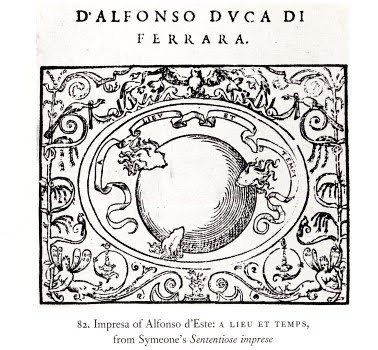
It is also possible that the globe on which Opportunity is standing (school of Mantegna, below) was meant not only as something moving swiftly, as opposed to Wisdom's cube, but also as a cannon ball.
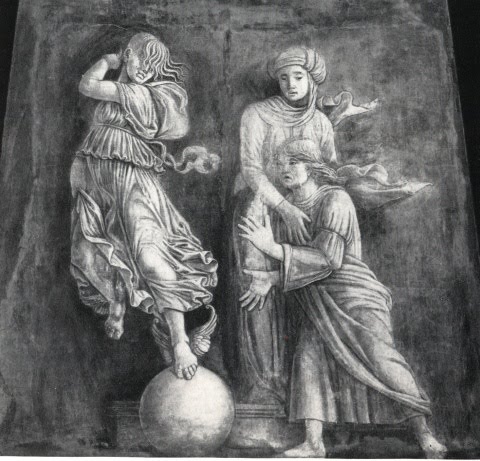
Ferrara seems to have been particularly sensitive to the role of gunpowder in changing the face of warfare, having experienced it first-hand in the Salt War. I discussed how tarot may have affected tarot imagery in my "Shakespeare and Tarot" posts. Search for the terms "gunpowder" and "cannon" at viewtopic.php?f=12&t=630&start=0.
I am aware of Jewish alchemists going back to ancient times, and active in 15th century Italy. There is a book of translations of their writings, The Jewish Alchemists, by Patai (http://books.google.com/books?id=LorvA_ ... &q&f=false). Frustratingly, it is not always clear whether these works were actually written by the authors claimed, or written later and attributed to earlier famous names. The editor/translator doesn't seem much interested in that issue.
I quoted the relevant part of Chaucer's "Canon's Yeoman's Tale" in my survey of 14th and 15th century alchemy, viewtopic.php?f=11&t=647#p9645.
Thanks for the additional "echecs" pictures. They help in clarifying what the standard iconography was. I am now perusing Liebeschutz's Fulgentius Metaforalis: Ein Beitrag zur Geschichte der antiken Mythologie im Mitelalter. It's hard for me to read, but there certainly are some interesting images. Later for that.
Gunpowder of course is Chinese, invented by Chinese alchemists. There is an interesting book about the history of gunpowder, which talks about the role of alchemists in the West in adapting the invention to particular applications such as guns and mining, http://books.google.com/books?id=8o8EIs ... &f=false.I don't recall the author mentioning Jews in particular as conveying the invention westward, but my memory is fuzzy. The Chinese used gunpowder in warfare a lot early on. But they apparently became so horrified by its destructiveness that by consent on all sides they banned it--as a weapon of mass destruction, I presume. Not a bad idea.
In Italy I think the use of gunpowder, which didn't dominate warfare there until after the invention of the tarot, changed the way in which the tarot court cards were drawn, especially Batons and Swords, so that instead of optimistic court figures, we have ones who look upset. A similar change in attitude toward warfare was reflected in literature, from Ariosto to Shakespeare. Pictorial art besides the tarot also picked up on the change, for example Alfonso d'Este's posturing with his cannon (in the painting by Titian, http://en.wikipedia.org/wiki/File:Alfon ... olitan.jpg) and various impressa, a craze that Wind says was started by Frederico de Montefeltro.

It is also possible that the globe on which Opportunity is standing (school of Mantegna, below) was meant not only as something moving swiftly, as opposed to Wisdom's cube, but also as a cannon ball.

Ferrara seems to have been particularly sensitive to the role of gunpowder in changing the face of warfare, having experienced it first-hand in the Salt War. I discussed how tarot may have affected tarot imagery in my "Shakespeare and Tarot" posts. Search for the terms "gunpowder" and "cannon" at viewtopic.php?f=12&t=630&start=0.
I am aware of Jewish alchemists going back to ancient times, and active in 15th century Italy. There is a book of translations of their writings, The Jewish Alchemists, by Patai (http://books.google.com/books?id=LorvA_ ... &q&f=false). Frustratingly, it is not always clear whether these works were actually written by the authors claimed, or written later and attributed to earlier famous names. The editor/translator doesn't seem much interested in that issue.
I quoted the relevant part of Chaucer's "Canon's Yeoman's Tale" in my survey of 14th and 15th century alchemy, viewtopic.php?f=11&t=647#p9645.
Thanks for the additional "echecs" pictures. They help in clarifying what the standard iconography was. I am now perusing Liebeschutz's Fulgentius Metaforalis: Ein Beitrag zur Geschichte der antiken Mythologie im Mitelalter. It's hard for me to read, but there certainly are some interesting images. Later for that.
Re: Tarot-like images in a c.1420 manuscript
10No doubt about this ... but let's assume, that Christianity got some gun powder from the Mongols ... then they still had the problem to reproduce the material with own force. So alchemic research might have been necessary to get insight about this process.mikeh wrote: Gunpowder of course is Chinese, invented by Chinese alchemists.
It's indeed Alfonso d'Este, who showed particular interest, likely since his engagement his participation in 1494/95 war.Ferrara seems to have been particularly sensitive to the role of gunpowder in changing the face of warfare, having experienced it first-hand in the Salt War.
Suddenly ...
http://www.crvp.org/book/Series04/IV-3/ ... _italy.htm
Well, a strange sign of Tarot .... I was aware, that Alfonso had a lot to do with cannons, but I didn't know, that there were two cannons of special importance, and that these two had names: Gran Diavolo and Terremoto, with "Terremoto" meaning "earth quake".In 1508 the League of Cambrai had allied Emperor Maximilian and King Louis XII of France against the Venetians for the partition of the territory of the Republic. The League ends in 1510, setting Pope Julius II free to try to expell the French from Italy. Alfonso, Duke of Este, is at the side of the French, providing with his two famous guns, Gran Diavolo and Terremoto, the best part of their artillery. Fighting takes place all over around Ferrara. The Pope now proclaims The Holy League with Venice and Spain against the French and Ferrara -- which, by the way, had been for centuries a fief of the Vatican. The Duke of Este and General Bayard cut to pieces the Papal forces. In 1511 the Spaniards and the Papal Army enter the territory of Ferrara. Yet, the young French General Gaston de Foix moves triumphantly from one victory to the next. Joined by Alfonso's powerful artillery, Gaston de Foix fights on Easter Sunday , April 11, 1512, the bloodiest battle fought on Italian soil since the overthrow of the Goths: the battle of Ravenna, a city a short distance from Ferrara. The dead included 4,000 Frenchmen and 10,000 confederates; all Spanish and Papal leaders are captured. Gaston de Foix is killed when the fighting is almost over. Alfonso's artillery is a decisive factor in the final victory, as well as in the cruel death of thousands of people. When the fighting is over, he tries in vain to restrain the French from committing atrocities against the unarmed people of Ravenna.
Well, taking the 5x14-theory serious and also the conclusion, that the 6 added cards formed a deck with 20 special cards first, we have a Diavolo and a Lightning (Sagitta) forming the last "two added cards" at an unknown date.
Now we have two "most important Ferrarese cannons" called "Gran Diavolo" and "Terremoto" (I hope the similarity between earth quake and lightning results is accepted) from Alfonso d'Este, a dedicated specialist for cannons, who also was involved in the production of Tarocchi card ... actually the first, which had this new name "taroch".
http://www.rionesanpaolo.com/index.php? ... iew&gid=58
... this article give some information to the cannon names used by Alfonso, but the additional "named cannons" possibly didn't exist around 1509/10, when Alfonso started to become famous for his cannons, with which he occasionally decided the battles.
I've variously developed arguments in the past, that it was Alfonso, who took a deciding influence on the name change from Trionfi cards to Taroch cards, possibly even setting up some of the final steps to the form, which we know call Tarot.
The words gran diavolo and terremoto appear then in Ariost's "Orlando Furioso" (Ariost: a poet in Ferrara and the Orlando-theme: a Ferrarese product) in the description of the hero Ruggiero ...
Ruggioro's role is described here:
http://en.wikipedia.org/wiki/Ruggiero_%28character%29
... we have to see, that ...
Ruggiero is a identification figure for the d'Este in Ferrara, and the relation to Africa might reflect the real condition, that Alfonso had some moorish ancestors (by his Aragon mother) and is said to have looked a little darker than the usual Italian.Ruggiero is the subject of two possible prophecies. His first possible fate is to convert to Christianity, marry Bradamante and sire a line of heroes that lead to the noble house of Este in Italy, but will be betrayed and killed soon after his marriage. His second possible fate is to remain a Saracen and be the cause of the downfall of the Frankish Empire. Atlante is fiercely protective of Ruggiero and keeps him hidden in an invisible castle on the top of Mount Carena in Africa.
The Italian Orlando-passage is noted here:

... which seems to mean, that Ariost in common "honour to the duke" points with Ruggiero to Alfonso d'Este himself.
Huck
http://trionfi.com
http://trionfi.com
Re: Tarot-like images in a c.1420 manuscript
11Good work, Huck, on the cannons. I have to confess that I have read about those cannons elsewhere recently, I can't remember where. But the significance of the names didn't register with me. Also, I had always assumed that those two cards came from further south, Bologna or Florence, because of the Tower in the Charles VI deck, which I assume dates from before the Steele Sermon's mention of both cards. But the Charles VI's designs may not be that old, and the two cards may well be Ferrarese. (Did I read you right, that you were suggesting that they were a Ferrarese contribution to a deck which earlier, in Milan at least, had had 20 cards at one point?) I will try to remember where else I've read about the cannons.
On alchemy and gunpowder, I have to go back and re-read Kelly. Maybe the bit about the cannons was in there.
On alchemy and gunpowder, I have to go back and re-read Kelly. Maybe the bit about the cannons was in there.
